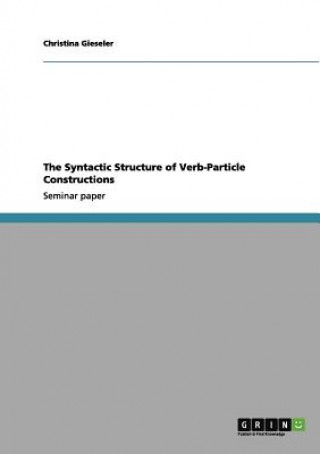
Livraison
Guide d'achat
16 126 809 livres à l’intérieur 175 langues






Afficher toutes les langues (175)
2 047 052 livres numériques à l’intérieur 101 langues






Afficher toutes les langues (101)





Cela ne vous convient pas ? Aucun souci à se faire ! Vous pouvez renvoyer le produit dans les 30 jours
 Bon d’achat
n'importe quelle valeur
Bon d’achat
n'importe quelle valeur
Impossible de faire fausse route avec un bon d’achat. Le destinataire du cadeau peut choisir ce qu'il veut parmi notre sélection.
Syntactic Structure of Verb-Particle Constructions
 Anglais
Anglais
 100 b
100 b
 common.delivery_to
common.delivery_to
Politique de retour sous 30 jours
Ceci pourrait également vous intéresser


Seminar paper from the year 2011 in the subject English Language and Literature Studies - Linguistics, printed single-sided, grade: 1,0, University of Wuppertal, language: English, abstract: IntroductionVerb-Particle Constructions occur in most, if not all, of the Germanic languages (Dehé: 2002:1, Olsen 2000:149). They are also known as verb-particle combinations , phrasal verbs , particle verbs (PVs) or separable (complex) verbs (cf. Dehé ibid., cf. Dehé, Jackendoff, McIntyre, Urban 2002:1). VPCs formally consist of a verbal stem and an intransitive prepositional or adverbial element , a so-called particle (Olsen 2000:149).In linguistic research, there is no uncontroversial definition of particles which reliably demarcates them from similar items and has cross-linguistic validity (Dehé et al. 2002:3)[...]According to Dehé (2002), the perhaps most striking property of transitive PV s in English is their appearance in two alternating orders (3) as the English particle can appear on either side of a direct object, unless it is a (non-contrastively accented) pronoun (Dehé et al. 2002:2, cf. Jackendoff ibid.). In the so-called continuous order the particle is adjacent to the verb and precedes the DP-complement as in (1) (Dehé 2002:3-4). In the discontinuous order the particle follows the DP-object (cf. 2) (ibid.). In this order the use of unstressed pronouns is obligatory as illustrated in (3) (ibid.; the following examples are borrowed from Dehé:ibid. as well).(1) He wiped off the table.(2) He wiped the table off.(3) a. He wiped it off. b. He wiped off it.Concerning the syntactic structure of English VPCs, several questions might be asked:1. How does the syntactic structure of VPCs in English look like?2. How do the alternating word orders come about?3. Which of the word orders is the underlying one?Linguists have developed many different approaches to the syntactic structure of VPCs. This paper is going to focus attention on three different syntactic analyses for English VPCs and attempts to answer the questions posed above. Before presenting the different approaches, some basic characteristics of English VPCs will be introduced. Afterwards, the approaches, namely the Small Clause analysis according to Kayne (1985) and two different complex head analyses by Johnson (1991) and Dehé (2002), will be elucidated and discussed.
À propos du livre
 Anglais
Anglais


 Contact
Contact Comment faire ses achats
Comment faire ses achats

























